A Closer Look: Tire Pressure Monitoring Systems (TPMS) Operation
TPMS System Overview: A Closer Look at this Important Safety System
Tire Pressure Monitoring Systems have been mandated for over 14 years but have been on vehicles for much longer. Yet they still seem to spark a love/hate relationship. Some motorists and techs find them a nuisance, while others recognize a valid safety device and prime service opportunity. TPMS brought a lot of new terminology – initiate, program, activate, clone, protocol and relearn. There have even been mixed messages sent from the industry. Ultimately, this is a safety system that warns drivers of issues with their tires and protects motorists from potential danger.
Indirect TPMS
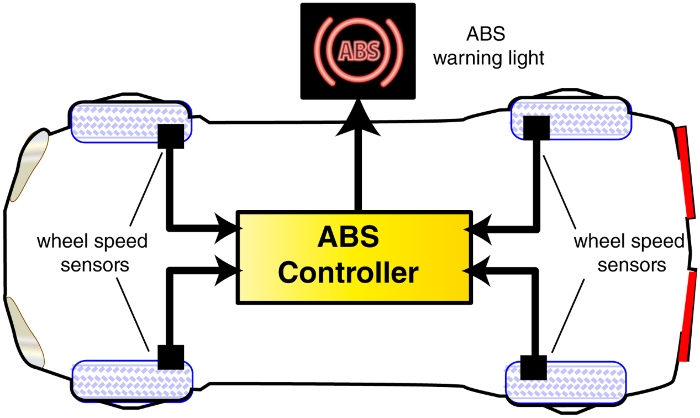
Indirect systems rely on the ABS Brake system to monitor and compare wheel speeds to make sure they are all rotating in the same speed range. When a tire begins to lose air, it becomes smaller in diameter, which causes it to rotate faster than the others. The ABS speed sensor on the low tire’s wheel reports a frequency signal that increases when compared to the other tires – this activates a TPMS warning light. Rolling circumference of a tire may change due to:
- Insufficient tire pressure
- Structural damage on tires
- The vehicle is loaded heavily on one side
- One axle is heavily loaded (i.e. when pulling a trailer)
- When snow chains are used
- When a spare tire is installed
This TPMS system can detect under-inflation in up to three tires simultaneously but not all four. Since the indirect system compares wheel speeds, if all four tires lose the same amount of air the relative change will be zero.
Direct TPMS
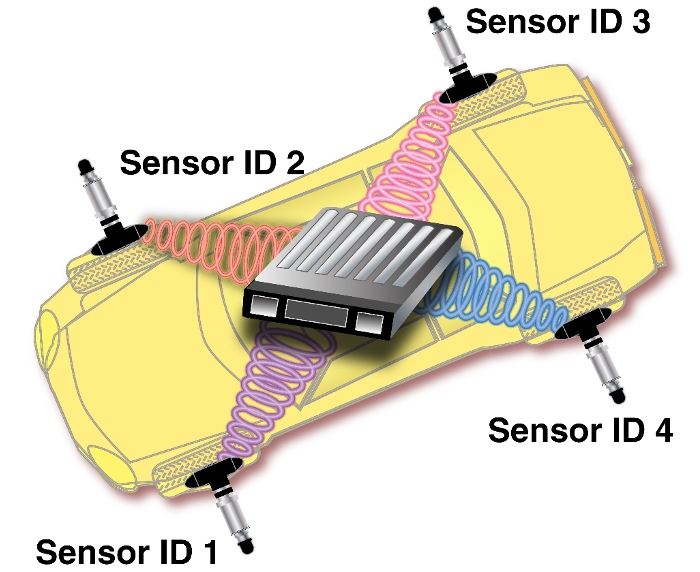
Direct TPMS systems consist of a control module (often it’s the same module as the Remote Control Door Lock Receiver, since they talk on the same frequency) and 4 or 5 sensors (one in each wheel, and sometimes the spare). The TPMS module receives real time data inputs from the sensors which transmit:
- Pressure
- Temperature
- Identification
- Accelerometer
The TPMS module then determines if the signal is below the manufacturer’s specified placard pressure threshold. If below the minimum, the module sends a request to the instrument cluster to illuminate the warning light. There are two main types of direct tire pressure monitoring systems – 'high line' and 'low line.’ High line systems will communicate specific information to the driver, and low line systems will communicate a generic message indicating that there is an issue.
TPMS Technology – Auto-Relearn
How Auto-Relearn Technology Works
Auto-Relearn automatically identifies each TPMS sensor, determines its position on the vehicle, and wirelessly transmits the information to the receiver for display on the dash – all without human intervention. For a better understanding, here are two popular Auto-Relearn technologies.
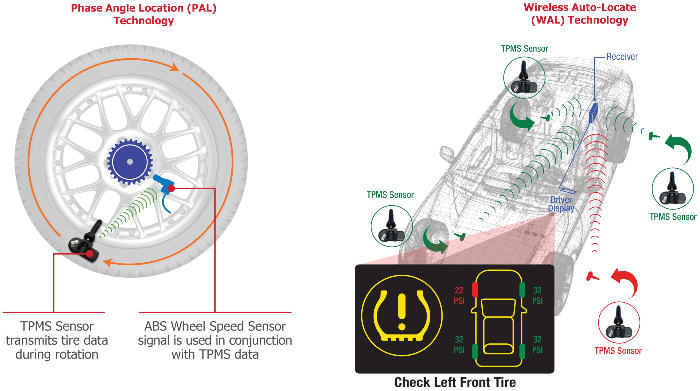
Phase Angle Location (PAL) Technology
Phase Angle Location uses ABS data along with TPMS sensor data to transmit tire pressure, temperature, position, and directional rotation while the vehicle is being driven. Vehicles equipped with PAL systems utilize the data to accurately identify the TPMS sensors’ location and pressure, which is shown on the driver display.
Wireless Auto-Locate (WAL) Technology
Wireless Auto-Locate systems use advanced TPMS technology along with RF signal strength to determine sensor location after installing a new sensor or tire rotation.
TPMS Sensors
When it comes to TPMS sensors, there are essentially two choices – OE-match or Universal. Each has its pros and cons.
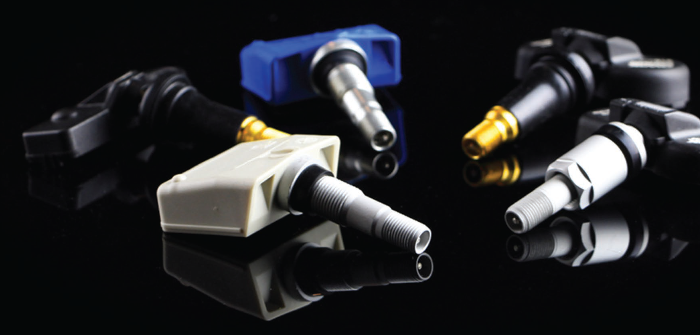
The OE-match sensor is a direct-fit, 1-for-1 sensor. Each sensor has a specific protocol built in, and there’s one sensor for one application. The OE-match sensor line is typically long and requires an inventory investment.
Advantages
- No programming or selecting needed, technician simply installs and performs the vehicle relearn
Disadvantages
- Must stock numerous SKUs to ensure coverage
- New OE applications = additional SKUs
Universal TPMS sensors come in a variety of offerings. Some have multiple protocols in them and broadcast all at the same time to communicate with whichever vehicle they might be installed on. Others are selectable. And still others require the protocols to be downloaded, which allows the technician to choose the application for a specific repair. The right sensor is always available.
Advantages
- As few as one SKU required to stock
- Ability to add new applications without adding SKUs
- Ability to copy ID from the original sensor
Disadvantages
- A TPMS tool is required to program and relearn the sensor
Best of Both Worlds – Standard® OE-Match and Standard® QWIK-SENSOR® Multi-Frequency TPMS Sensors
The Standard® TPMS program includes both options, delivering the best blended program in the industry. In addition to an extensive OE-Match direct-fit sensor line, Standard® has recently introduced QWIK-SENSOR® Multi-Frequency Single Sensor program.
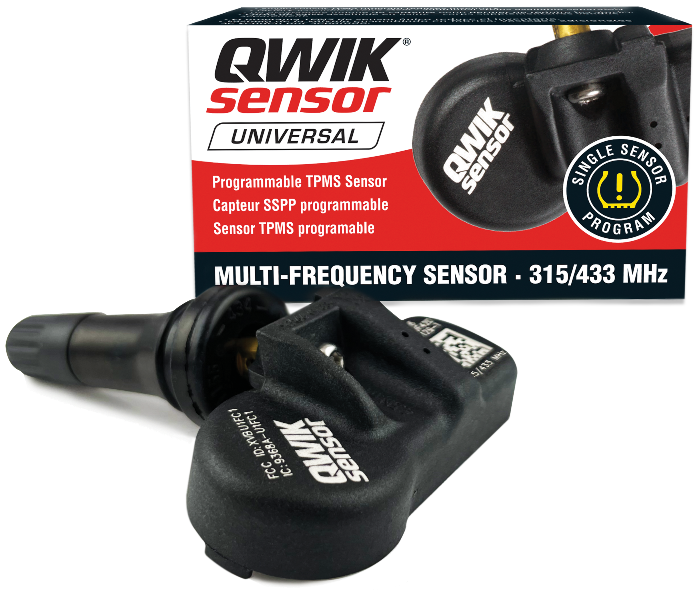
This New Multi-Frequency TPMS sensor combines 314.9, 315 and 433/434 MHz applications into one single SKU, reducing inventory for distributors and shops, while making TPMS sensor replacement more efficient for professional technicians. The QS106 comes complete with a factory-installed valve stem.
Faster programming times, surface-mounted dual-band antenna and longer battery life are just a few of the enhancements engineered into the QWIK-SENSOR® QS106. This Multi-Frequency sensor has been independently tested to match OE protocols for precise form, fit and function – including LOCSYNC, PAL, POD and WAL advanced technologies. Now, required TPMS sensor programming can be completed before or after installation, and while under pressure.
Today’s advanced TPMS sensors utilize technology such as accelerometers, multi-axis positioning and a dedicated Application Specific Integrated Circuit (ASIC) to determine sensor location and rotational direction. That's why it’s more important than ever to choose premium replacements like the Standard® QWIK- SENSOR® Multi-Frequency TPMS Sensor.
Standard® – The Complete TPMS Program
Whether it’s an ABS sensor for an indirect system, an OE-Match sensor or a universal sensor for direct systems – Standard® has you covered! In addition to the QWIK-SENSOR® Single Sensor Program, Standard® offers a full line of premium OE-Match TPMS Sensors, service kits and tools – a unique blended TPMS program offering 99% coverage.
Explore the Standard® advantage at QWIKSENSOR.com and StandardTPMS.com.
Check out TPMS videos on the Standard Brand YouTube channel.
